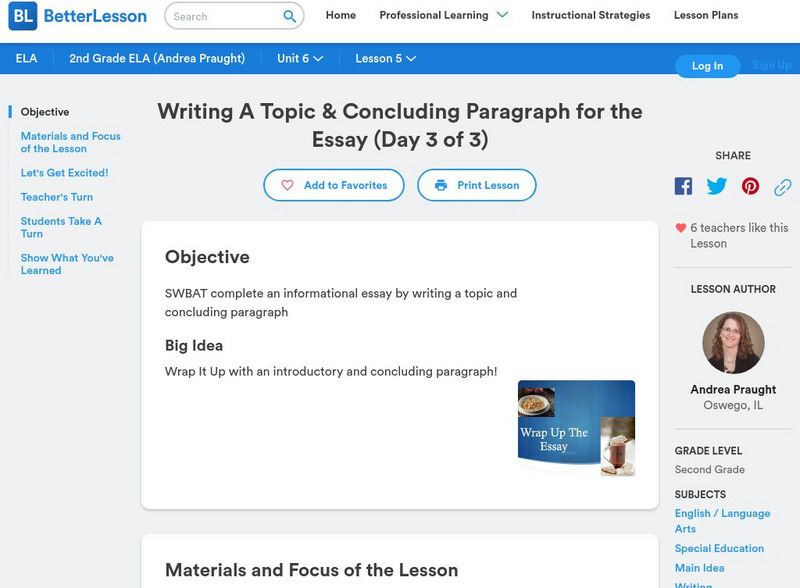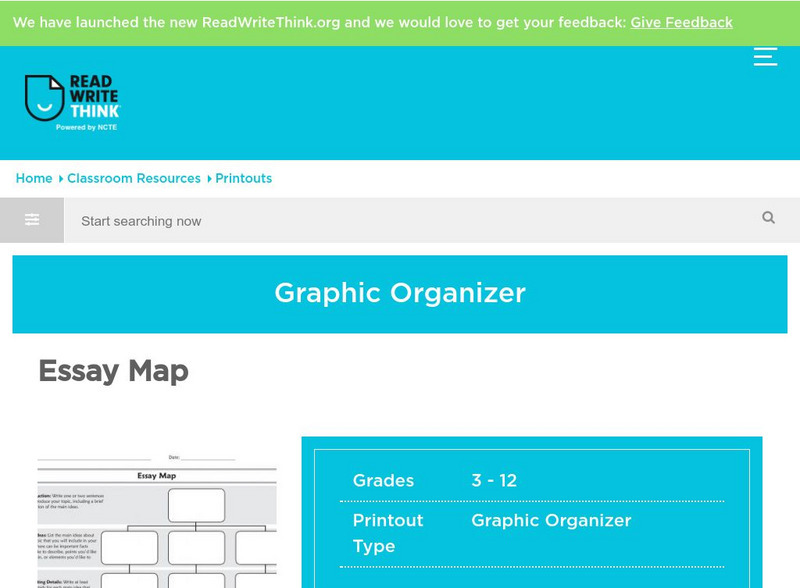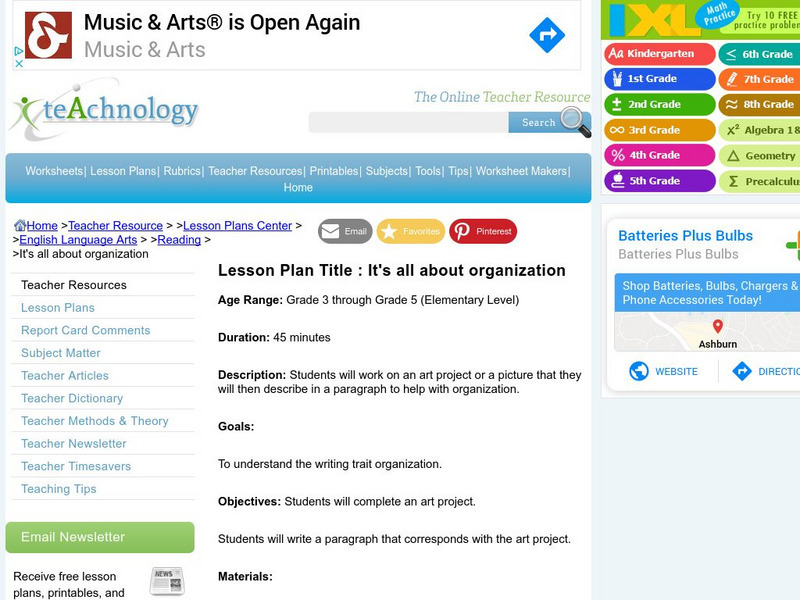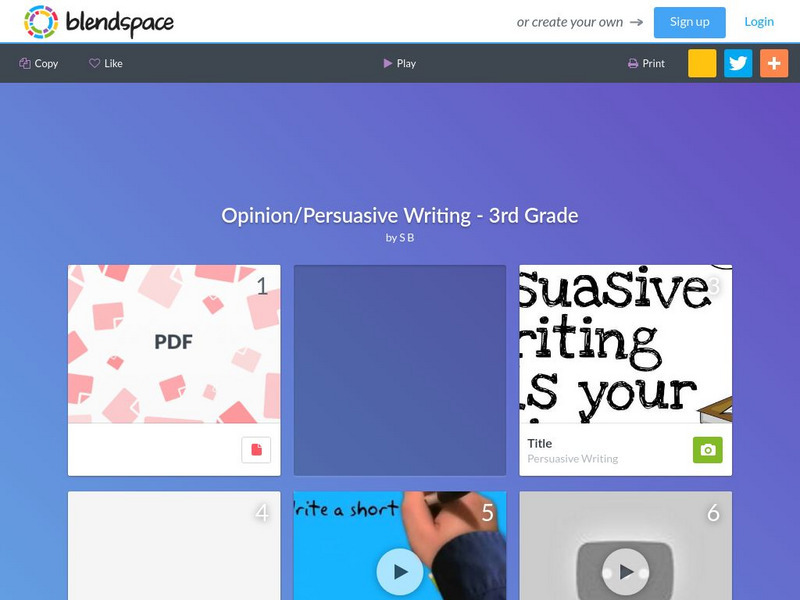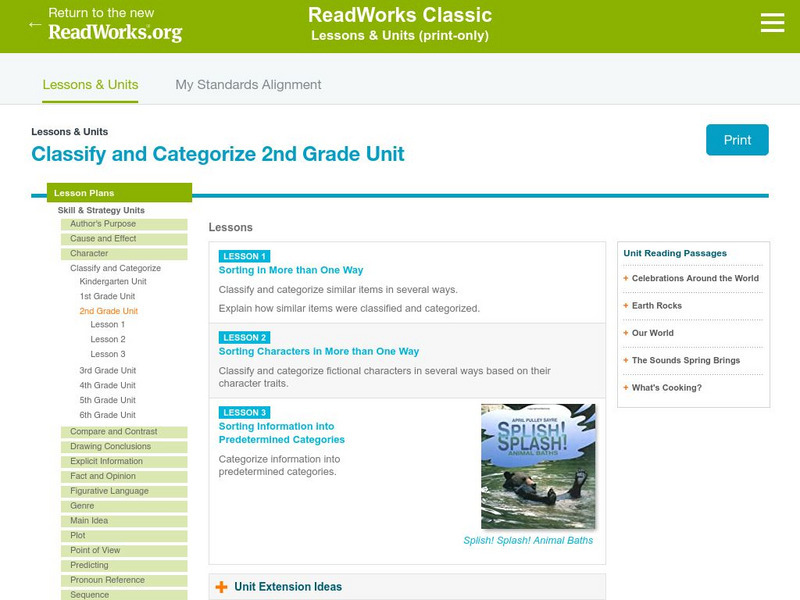Hi, what do you want to do?
Better Lesson
Better Lesson: Text Feature Diagrams
At the end of this lesson, young scholars will be able to identify and create diagrams associated with informational text. Included is a link to an eSpark video on diagrams, rules for group work, multiple examples of diagrams, and a...
CPALMS
Cpalms: Compare/contrast Life Cycle Texts
[Free Registration/Login Required] Young scholars will learn to compare and contrast texts about life cycles using a Venn diagram. Then, using the Venn diagram, students will write an expository paragraph including an introductory...
Better Lesson
Better Lesson: Writing a Topic & Concluding Paragraph for the Essay
This instructional activity is a final step towards supporting students to practice writing an informative/explanatory paragraph conveying complex ideas and presenting information clearly and accurately. Second-grade students can usually...
Better Lesson
Better Lesson: A Storm of Ideas
The first step in writing an informational text on the topic of students' choice is helping the student choose a topic of interest. Students will brainstorm ideas that will be possible final topics.
Utah Education Network
Uen: Third Grade Writing Lesson #2 / Science Prompt
Third graders will invent a gadget using one or more simple machines and write about it.
Writing Fix
Writing Fix: The Wacky Classroom Calendar
Inspired by Barry Lane's book 51 Wacky We-Search Reports, in this cross-curricular lesson students learn how to summarize properly.
Writing Fix
Writing Fix: The Wacky Advertisement (With Disclaimer) Activity
Inspired by Barry Lane's book 51 Wacky We-Search Reports, in this cross-curricular lesson learners learn how to summarize properly.
Beacon Learning Center
Beacon Learning Center: Web Lesson: Did I Read It: Implicit vs Explicit Details
Follow Carson through a lesson plan in order to become a better reader of informational text. Learn the difference between implicit and explicit information. Includes multiple interactive assessments and reading activities.
ReadWriteThink
Read Write Think: Essay Map
A fillable essay map in PDF format with boxes for an introduction, main ideas, supporting details, and a conclusion. Directions on how to use this type of graphic organizer as well as lists of teaching ideas and related resources are...
ReadWriteThink
Read Write Think: Technical Reading and Writing Using Board Games
Contains plans for a game that helps teach technical reading and writing while reviewing a novel that learners have read. In addition to objectives and standards, this instructional plan contains links to sites used in the lessons as...
ReadWriteThink
Read Write Think: Research Building Blocks: Skim, Scan, and Scroll
Contains plans for two lessons on locating supporting details that are part of a larger unit on researching a state symbol. It works on skills like determining the most important information, using key words to identify relevant...
Other
Samples of Informative Writing Prompts
The Mississippi Department of Education offers a sample of informative writing prompts. Great ideas for teachers and students.
Read Works
Read Works: Genre Studies: Informational Texts: Pictures and Photographs
[Free Registration/Login Required] Lesson uses All About Cats and Kittens by Emily Neye to teach students how to identify facts from photographs and pictures in informational text. Ideas for direct teaching, guided practice, and...
Writing Fix
Writing Fix: Question and Answer Books
Beginning writers work through a Writing Workshop format to create Question and Answer books. A series of mini-lessons, graphic organizers, possible texts, and samples of student work are all provided.
Writing Fix
Writing Fix: Summarizing Mathematical Learning With the Important Book
In this lesson, The Important Book by Margaret Wise Brown is used as a mentor text. Students will create an illustrated paragraph about a particular math topic. Students will use the mentor text and attempt to adapt the author's style to...
ReadWriteThink
Read Write Think: Identifying and Writing Effective Opening "Hooks"
Contains plans for four lessons that teach students to write effective "hooks," or beginnings, to their writing. They read the introductions of fiction passages and analyze the techniques they use before applying these techniques in...
Teachnology
Teachnology: Lesson Plan: It's All About Organization
In this lesson plan, third through fifth graders learn to organize their writing to form a cohesive paragraph. They began by making an art project such as a drawing; then they write sentences describing their art, and write an organized...
TES Global
Blendspace: Opinion/persuasive Writing 3rd Grade
A collection of resources that includes videos, images, activities, and graphic organizers to use while learning to write opinion and persuasive pieces.
Read Works
Read Works: Fit for Life
[Free Registration/Login Required] This passage explains concepts related to a healthy diet. This passage is a stand-alone curricular piece that reinforces essential reading skills and strategies and establishes scaffolding for...
Read Works
Read Works: A Ton of Trash
[Free Registration/Login Required] This informational text passage shares different projects that have been developed to recycle trash. This passage is a stand-alone curricular piece that reinforces essential reading skills and...
Read Works
Read Works: Classify and Categorize 2nd Grade Unit
[Free Registration/Login Required] A series of three lesson plans designed to teach students to classify and categorize items, characters, and information. The third lesson is based on the book Splish! Splash! Animal Baths by April...
Read Works
Read Works: Main Idea 4th Grade Unit
[Free Registration/Login Required] A two-lesson unit on main idea and details through which students use the topic sentence to identify the main idea of a paragraph and categorize details as main idea or supporting. With free login,...
Education Development Center
Tv411: Summarizing: Activity 3
In this activity, students choose the correct category to which details belong. Being able to categorize helps students to identify the difference between main ideas and details.
Better Lesson
Better Lesson: Compare and Contrast Informational Text
This third grade lesson plan engages young scholars in comparing and contrasting paired informational text passages about frogs. Students will use a Venn Diagram to keep track of the information.







